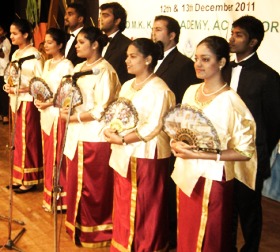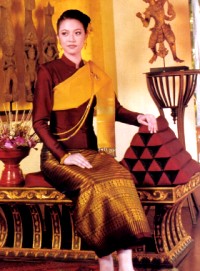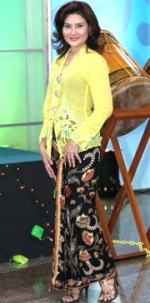East Asian influence on the Goan Mando

Since ancient times, hybridization brought on by colonization and migration has led to things related to human life such as culture, language, cuisine, and even garments taking on blended forms. Consider the unique Hindi we speak in a melting pot metropolis like Mumbai, or the way the Brits have absorbed chicken tikka into their repertoire of national dishes, or the way strange new varieties of yoga are sprouting in the United States, and you’ll get the picture.
The Goan Mando, like all other hybrids that evolved out of the mixing of cultures, has many captivating features. Interestingly, in addition to its music and dance components, the costumes worn by the men and women performers also exhibit a fascinating fusion of east and west. The Lusitanian impact is the most evident, but how many Mando lovers are aware of the Malay or East Asian influence on the Goan Mando?
Don’t know about you, but I’ve always been intrigued by the costumes worn by women in a Mando performance. Called the bazu-torhop (todop), or pano-baju, the outfit looked distinctly Oriental to me, reminding me of Myanmar’s Aung San Suu Kyi or Burmese women in general. So I decided to put on my researcher’s hat and solve the mystery. And here’s what I found out.
The male performers, who formerly used to wear a cabai – a knee-length loose white top – later took to wearing a formal, European-style, 3-piece suit. But the women’s 2-piece attire, a short embroidered top (bazu) worn over a sarong-type, ankle-length skirt (torhop) with a folded scarf or shawl (tuvalo) thrown over one shoulder has undoubtedly been fashioned after the garments worn by women across East Asia, particularly in regions that once formed a part of Portuguese Asia such as Malaysia, Timor and Macau, and also other countries like Thailand, Singapore, Laos and Myanmar.
Origin of the Goan Mando costume
 During the colonial era, Portuguese and Dutch ladies arriving from Sumatra, in northwestern Indonesia, wearing body-fitting, embroidered tops with long sleeves (a modification of the blouses worn by native women there), visited or settled in parts of the Malay Peninsula. Apparently, the stylish outfits these European ladies wore inspired the evolution of the Malaysian baju-kebaya traditionally worn over a sarong. It is believed that Goan women returning from Portuguese colonies like Malacca (in Malaysia), Timor and Macau introduced such oriental styles of dress to Goan society and then women belonging to the upper and middle classes took to wearing it for special occasions. Eventually, the bazu-torhop became the accepted costume for women whenever they performed Goan Mandos. The female outfit also has touches of the formal dress that was worn by rich women of the Chinese Ming dynasty. For instance the torhop is made out of silk or velvet and has an embroidered border, and the women wear ornaments in their hair like the Chinese women did. The Chinese connection came about through traders and vendors from China who brought richly embroidered Chinese textiles to Goa and other parts of India and South-East Asia.
During the colonial era, Portuguese and Dutch ladies arriving from Sumatra, in northwestern Indonesia, wearing body-fitting, embroidered tops with long sleeves (a modification of the blouses worn by native women there), visited or settled in parts of the Malay Peninsula. Apparently, the stylish outfits these European ladies wore inspired the evolution of the Malaysian baju-kebaya traditionally worn over a sarong. It is believed that Goan women returning from Portuguese colonies like Malacca (in Malaysia), Timor and Macau introduced such oriental styles of dress to Goan society and then women belonging to the upper and middle classes took to wearing it for special occasions. Eventually, the bazu-torhop became the accepted costume for women whenever they performed Goan Mandos. The female outfit also has touches of the formal dress that was worn by rich women of the Chinese Ming dynasty. For instance the torhop is made out of silk or velvet and has an embroidered border, and the women wear ornaments in their hair like the Chinese women did. The Chinese connection came about through traders and vendors from China who brought richly embroidered Chinese textiles to Goa and other parts of India and South-East Asia.
 The bazu-torhop, as also the sarong-kebaya combination garments of the women of South-East Asia to which it bears a remarkable similarity, is truly such an attractive outfit. (So much more elegant than all those ‘let-it-all-hang-out’ outfits, no?) It is said that in the 19th century and maybe the early decades of the 20th as well, the wealthy Catholic women of Salcette made sure they had at least one bazu-torhop set in their wardrobe. Wonder why it went out of fashion?
The bazu-torhop, as also the sarong-kebaya combination garments of the women of South-East Asia to which it bears a remarkable similarity, is truly such an attractive outfit. (So much more elegant than all those ‘let-it-all-hang-out’ outfits, no?) It is said that in the 19th century and maybe the early decades of the 20th as well, the wealthy Catholic women of Salcette made sure they had at least one bazu-torhop set in their wardrobe. Wonder why it went out of fashion?
The Mando attire is too beautiful to be relegated to the annals of history or paraded as a costume only during Mando competitions, don’t you think? Hmmm… a thought just struck me. Maybe I’ll pick up a sarong-kebaya when I visit Malaysia, though I don’t know when that will be, and a matching scarf to go with the outfit. But I guess I’ll have to huff and puff my way through some heavy duty exercising first if I want to flaunt my curves in regalia like that…

My family has done a lot of Konkani and English translations of mandos. To bring in the Malay and Chinese connection is great. Thanks for writing about this.
Thank you Sabino for the appreciation. It’s great connecting with someone whose family also feels so passionately about the Goan mando. By the way, where are you based?
Just saw a movie the Malay Chronicles — based on an epic which depicts the Goan connection during the Roman era. The pre-Portuguese Goa.
Yes Elfred, it’s only when we read history or see films based on olden times that we discover interesting connections between between far away lands, including territories like Goa.
Dear Madam,
I just love this article on the Malay connection of the Mando. I’m spending this lockdown reading stuff about my ancestral state of Goa.
Regards,
Anish Esteves
Thank you, Anish. Yes, reading can be enriching whether under lockdown or not.
Never knew about the oriental connection. Was an eye opener. But if one looks closely, it does seem oriental. It is a very regal n graceful dress. Remember wearing a purple velvet outfit for a mando competition.
Thanks for writing in, Elvina. Taking part in the mando competition must have been a great experience.
Jan Huygen van Linschoten (1563-1611) wrote in his book Itinerario that the Mestizo women of the Indies wore ‘baju’ what he calls the usual dress of Portuguese women.
So I find it more likely the Portuguese (Portuguese and Indians with a Luso-Asian culture) introduced the baju in Malaysia and Indonesia together with the saya/saia (skirt), kebaya/cabaia and kondé/kondai (hair twist) among other fashion items.
Thanks a lot for sharing that interesting bit of information about the most likely origin of the baju and other clothing found in Portuguese colonies in the past.